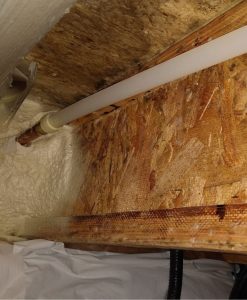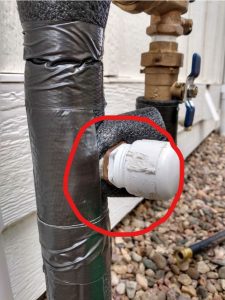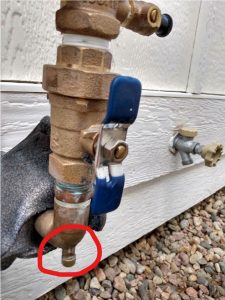An irrigation system and sprinkler blowout is a necessary service to perform before we experience a hard freeze in the fall. Usually, the term hard freeze is used to describe a period when temperatures are sufficiently cold for a long enough time to seriously damage or kill seasonal vegetation, or in our case, to freeze the water inside your outdoor plumbing. We’ve already discussed the necessity of unhooking your garden hose during freezing temperatures, and now we will walk you through the steps of a sprinkler blowout to help your irrigation system.
Step 1: Water Line Location
First, you will want to locate the water line to the irrigation pressure vacuum breaker, which is also referred to as a PVB (See Fig. 1).
Figure 1 (PVB)
Step 2: Shut-off Valve & Drain The Water
Once you locate the water line to the PVB in your crawlspace or basement mechanical room (See Fig. 2), trace it back to find the shut-off valve to the line. Turn the shut-off valve to the off position (See Fig. 3). The shut-off valve should contain a small drain with a ¼” brass cap. Prepare a bucket underneath the shut-off valve and unscrew the small drain cap. The remaining water in the line to the PVB will drain out into the bucket.

Figure 2 (Water Line from PVB) Figure 3 (Drain Cap on Shut-Off Valve)
Step 3: Tape Small Brass Drain Cap
Once all the water is drained, we recommend leaving the drain cap off for the winter and leaving a bucket underneath in case the shut off valve is allowing a small amount of water to get by. You can tape the small brass drain cap to the top of your sprinkler timer so it will be waiting there for you in the spring.
If you are unable to complete these steps, either because your shut-off valve does not have a drain or because there is no shut-off valve to the PVB, we recommend that you call our office to schedule a licensed service technician to come out and install the correct valve for your sprinkler blowout.
Once the water is drained from the water line to the PVB, go outside and inspect the PVB setup. There should be a small brass drain valve on the PVB as well (See Fig. 4). Unscrew the small ¼” brass drain cap to drain any remaining water upstream of the PVB and replace it once all the water has drained. Since you already completed this step inside as well, it is alright if your PVB setup does not have this drain on it.
Figure 4 (PVB Drain Cap)
Final Steps To Blow Out The Water
To blow out the water in the irrigation system, close both of the ball valves located on the PVB and attach your air compressor hose to the blowout tee (See Fig. 5 & 6). You will likely need to purchase the correct fittings to adapt the air compressor fitting onto the blowout tee. If you find that your system does not have a blowout tee next to the PVB, we do NOT recommend blowing out through the fittings on the PVB itself. This can cause damage to the parts inside the PVB and end up costing you more than getting the correct blowout tee installed in the first place. Contact our office at 970-226-9979 for more information on pricing and availability to have a blowout tee installed on your pressure vacuum breaker.


Figure 5 (PVB Blowout Tee) Figure 6 (PVB Blowout Tee)
If you have drip system irrigation, do not use air pressure higher than 30 PSI to blow out your system. Some drip systems have drain plugs installed at the end of the lines and do not require a blowout at all. For a sprinkler system, open the system valves, which are underground inside the valve box, one by one and use approximately 80 PSI to blow out each zone separately.
Once water has been cleared from all the lines, disconnect your air compressor and reinstall the blowout tee cap. Turn both of the PVB shut off valves to a 45 degree angle. This will allow any remaining water to drain out. Finally, turn off your sprinkler timer and remove the battery if applicable.
There you have it! We wish you the best of luck with your irrigation system and sprinkler blowout, don’t hesitate to call us for more information or assistance.




